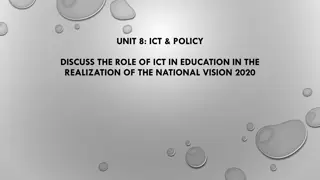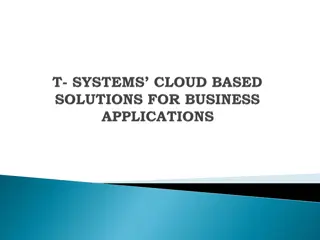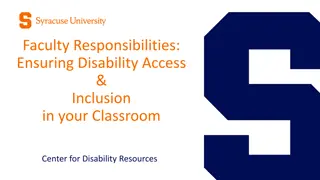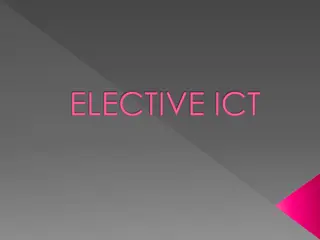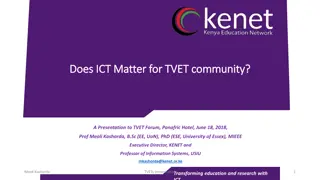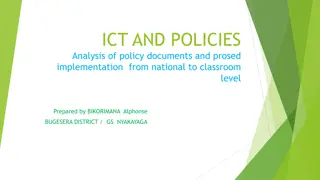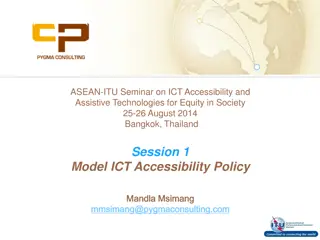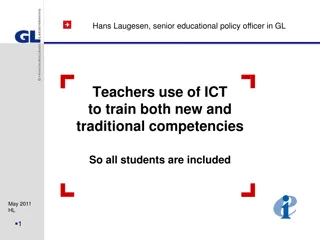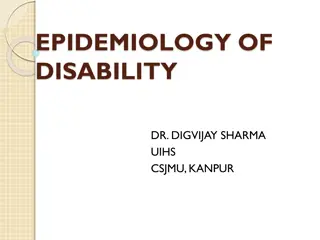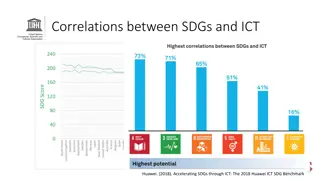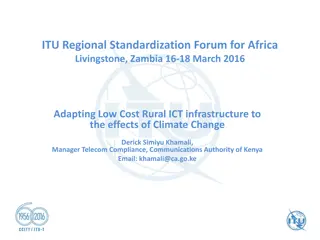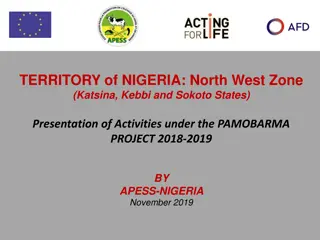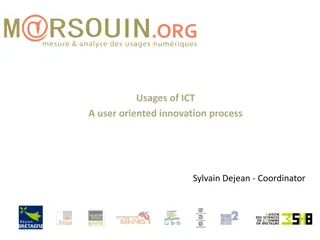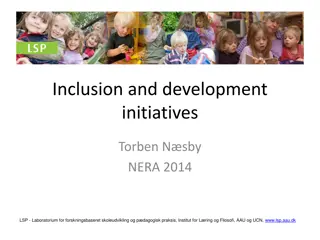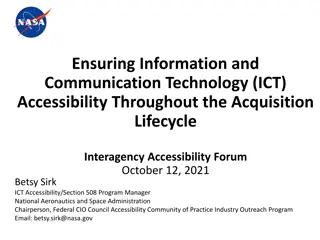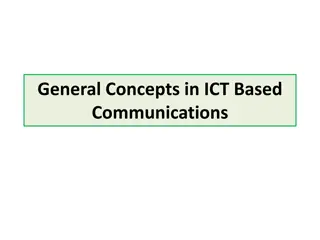Enhancing Disability Inclusion Through ICT in Nigeria
Nigeria has shown significant progress in utilizing ICT for government activities, internet services, and online platforms. The country is also focusing on enhancing accessibility for persons with disabilities by increasing awareness and use of ICT within the disability community. While challenges like additional costs persist, innovative assistive technologies are helping overcome barriers to access and affordability.
Download Presentation

Please find below an Image/Link to download the presentation.
The content on the website is provided AS IS for your information and personal use only. It may not be sold, licensed, or shared on other websites without obtaining consent from the author.If you encounter any issues during the download, it is possible that the publisher has removed the file from their server.
You are allowed to download the files provided on this website for personal or commercial use, subject to the condition that they are used lawfully. All files are the property of their respective owners.
The content on the website is provided AS IS for your information and personal use only. It may not be sold, licensed, or shared on other websites without obtaining consent from the author.
E N D
Presentation Transcript
PAPER PRESENTED AT 2015 UNDESA/DSPD FORUM ON DISABILITYAND DEVELOPMENT THEME: Disability Inclusion and Accessible Urban Development In Collaboration with UN Habitat (UN Convention Center Nairobi, 28-30-2015)
The management of government activities and process in Nigeria is relatively new; spanning less than three decades. However, Nigeria offers one of the fastest growing ICT markets in the world. Growing from less than 400,000 phone lines before 2000 to over 100,000,000 lines as at 2015. advent of ICT and its use in the
The level of awareness and use of internet services millions of websites owned by individuals, private and public as well as governmental organizations. This is greatly complemented by the array of social media platforms widely subscribed to by Nigerians in their tens of millions. has also increased rapidly with
Nigeria has made significant progress in the provision of online services and the use of ICT to drive the delivery of government operations, functions, activities and services. However, the country has not fully reached the transactional and network stage.
Certainly, the quality of ICT services is still low relatively potential Nigeria is endowed with and the vastness of her size and population. and the poor human scope when of compared material coverage is still the with resources and
With regard to persons with disability to ICT, the level of awareness, access to and use of ICT in the Nigerian disability communities also rapidly increasing. inclusion and access for
Although the additional cost incurred due to the remains a major barrier, the sensitivity of the innovativeness of foreign ICT manufacturers and vendors to the access of persons with disabilities is greatly helping persons with disabilities overcome these challenges, especially those imposed by cost and affordability barriers. necessity of assistive technologies in Nigeria to substantially
However, persons with disabilities are still confronted by huge inclusivity and accessibility barriers with inclusivity requirements and needs of persons with disabilities especially in locally produced and deployed ICT hardware, content and services. on the local ICT environment, regard to and the consideration accessibility of rights, the
The low level of inclusion and accessibility of disability into local ICT products and services in Nigeria is largely caused by very low awareness and technical capacity among policy-makers, ICT professionals and practitioners, as well as the lack of and/or inadequacy of appropriate legal, policy and institutional frameworks required to facilitate, enhance and sustain inclusive policies and practices in the use of ICT to drive E-access and E-government in Nigeria.
The accessibility needs of persons with disabilities into government levels in Nigeria is relatively new. mainstreaming of inclusivity and laws, policies at and programmes and of national sub-national
Before the commencement of Nigerias new democratic government policies administered disability issues models government disability Rehabilitation established within national and state ministries of social development. dispensation in 1999, through of the medical Therefore, and charity the charge disability. department was only in of of the Directorates
Even between 1999 and 2008, governments at national and sub-national levels in Nigeria hardly connection with issues like physical planning and urban development. thought that disability had any
Similarly, considerations for disability E-accessibility rights, development of E-government platforms and services transportation, development. At best, in Nigeria, it was easier to link disability strictly and only with sectors like education and health. there has been little or no requirements and needs in the especially in sectors infrastructural like housing,
However, the situation began to change slightly in Convention on Rights of Persons with Disabilities in 2006 which sparked-off more advocacies by civil organizations international eventual signing and ratification of the CRPD and its Optional Protocol in 2010. Nigeria upon the creation of the UN society groups with development and support disabled people s major and from partners the
At the moment, there are no national legal and guide the mainstreaming of inclusion and access of persons with disabilities across key sectors including physical planning and urban development as well as in the provision and deployment of ICT-driven E-governance of key health, education, etc. policy frameworks which holistically services like transportation, housing,
A National implemented Women Affairs and Social Development with some broad multi-sectoral policy approach. Rehabilitation by Policy is being the Federal Ministry of
evidences have shown that this task of inclusion and access for persons with disabilities has significantly overwhelmed a poorly staffed, poorly funded and incapacitated Directorate for Rehabilitation in the Federal and State Ministries statutorily charged with the responsibility of ensuring inclusion of persons with disabilities in all laws, policies and programmes jurisdiction. of government within their
Nigerias Federal Ministry of Information and Communication Technology has developed an E-Governance Master Plan with the purpose of strengthening transparency, efficiency and quality of public administration, in line with Vision implementing developed in 2012: 20:2020. The National Ministry is also a ICT policy,
Section awareness and proficiency in mass and non- formal education with emphasis on children, youth, women and persons with disabilities. 7.4.3 (strategy X): Promote ICT
Section marginalized groups (including persons with disabilities) become an integral part of the ICT stakeholder community as participants, innovators, leaders and beneficiaries of the knowledge economy in Nigeria s emerging information society. 7.5.3 (strategy viii): Ensure that
Section research and development of appropriate ICT devices for persons with disabilities to enable them enjoy the benefits of the ICT revolution in the country. 7.10.3 (strategy vii): Encourage
These remained on paper as they are not backed with appropriate legislative and institutional frameworks implementation. policy frameworks have virtually to effectively enforce
At commercial capital of Nigeria, where more than 50% of the ICT market and industry thrives, the state ICT policy managed by the State Ministry of Science and Technology is not disability sensitive. the local level; in Lagos state, the
In objectives and functions of the implementing Ministry dwells on the need to make ICT inclusive of, and accessible to persons with disabilities. Similarly, no specific strategies or programmes designed as part of the policy. fact, no section of the policy nor or activities are stated or
The Lagos State ICT policy runs contrary to the provisions of the State s disability law, The Lagos State Special People s Law, 2011 which disability law in Nigeria. The law provides that: is about the most comprehensive
(Section disability shall have freedom of expression and opinion, including the freedom to seek, receive and impart information and ideas through any means of communication of their choice. 30. Sub1) Persons living with
(Sub 2) Government, Corporate organization and intended for the general public to persons living with disability in accessible formats and technologies kinds of disabilities and at no additional cost. persons shall:(a) provide information appropriate to the different
Most government and privately owned ICT tools software, etc designed for the purpose of delivering E-governance in Nigeria are not prepared features for persons with disabilities. and platforms such as websites, with appropriate E-accessibility
For persons accessibility while attempting to use websites of National examination bodies, federal and state ministries and agencies, including those in traffic citizens identity and residency registration, public service recruitment, scholarships, etc. instance, blind complained and partially of sighted very have poor charge of lands management, registration, housing, national and state
Persons with disabilities are not included as targets/beneficiaries of national and local ICT skill development programmes, as well as in the monitoring programmes which are mostly targeted at children and youths. design, planning, and implementation, evaluation of such
Virtually training centers set up by federal, state and local accessible to persons with disabilities. These centers also lack relevant assistive aids and technologies accessibility for persons with disabilities. all ICT skill development and governments are not physically required to guaranty E-
The Lagos state government in partnership with organizations states) have been supporting the setting-up of public E-libraries and ICT skill acquisition centers for youths in the state. None of these facilities support E-accessibility of persons with disabilities. some prominent (and Multinational several indeed other
Low awareness and capacity are obvious gaps and actual reasons why E-accessibility provisions in challenging Although most hardware components, softwares and content of assistive technologies are not produced locally, the failure of academic and research institutions as well as weak policies are key hindrances which continue to aggravate low capacity. the delivery E-governance persons of remain to with disabilities.
Nigeria is still at the elementary levels of E- governance. The quality and scope of E- access for the general population is still relatively low. However, this offer a good opportunity for a holistic review of existing legal and policy frameworks for the purpose of ensuring that the rights, requirements and needs effectively embedded in the design, planning, implementation, monitoring and evaluation of emerging or new legal and policy regime. of persons with disabilities are
Persons with disabilities have resorted to self-help in confronting E-accessibility challenges. While there are no formal or organized capacity-building institutions and programmes in Nigeria, persons with disabilities have creatively and innovatively engaged with their foreign counterparts, international disability organizations, manufacturers and vendors of ICT, etc to acquire knowledge and skills.
However, disabilities are able to acquire professional and required to provide services and support to other persons with disabilities, agencies of government, the private sector, etc. only very few persons with service-based knowledge and skills
KEY LESSONS CONTINUED Executive Director Mr. Akinola Opeolu was training a blind person employed by a bank to use CISCO customer interactive software in Lagos, Nigeria. Mr Akinola Opeolu is the foremost self-trained assistive technologist in Nigeria with experience spanning over 2 and half decades. He is the founder and executive director heroes media. www.heroesmediang.com
KEY LESSONS CONTINUED Rasak Adekoya is a young and upcoming assistive technologist, inclusive leadership coach and brand strategies. www.360connect.media
The marginal level of E-access for persons with disabilities in Nigeria have been attained through strategic engagement between and among stakeholders including government, the organizations, ICT/Asssistive Technologists with development agencies, etc. private sector, disabled people s disabilities, local and international
For organizations have organizations to set-up ICT training Centers and/or training programmes. Similarly, persons with disabilities are also collaborating with non- disabled softwares and devices designed to enhance E-access for persons with disabilities. instance, prominent development with business agencies people s and collaborated disabled conduct ICT/Assistive Technology ICT professionals to develop
There difficulties which governments in low and middle income countries may encounter in implementing inclusive physical planning and urban development policies and programmes; especially reconstructing inaccessible infrastructure. are inherent financial and other considering or the cost of rehabilitating hitherto
We find that providing for the inclusivity and accessibility of persons with disabilities through robust and effective E-governance platforms which supports and delivers key services such as health, transport, management, etc will, in a more sustainable way, guarantee inclusive and towns and cities. rights, requirements and needs education, lands banking and and finance, traffic housing, accessible
Finally, the key lesson here is that in a country like Nigeria, it appears much easier to push for inclusive E-accessibility in E- governance platforms and processes than to ask that an inaccessible pedestrian bridge be pulled down. Therefore, if we can t gain physical access, we must gain electronic access.





